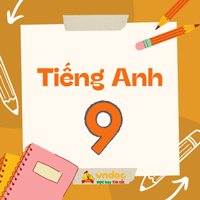SBT Tiếng Anh 9 Global Success Unit 10 Vocabulary & Grammar
SBT Tiếng Anh 9 Unit 10 Vocabulary & Grammar
Giải SBT Tiếng Anh 9 Global Success Unit 10 Vocabulary & Grammar hướng dẫn trả lời các câu hỏi trong SGK Tiếng Anh 9 Global Success Unit 10: Planet Earth, giúp các em nắm vững kiến thức được học trong bài và luyện giải bài tập Tiếng Anh 9.
1. Match the words and phrases with their definitions.
(Nối các từ và cụm từ với định nghĩa của chúng.)
|
1. flora and fauna |
a. a large area of water |
|
2. landform |
b. all the plants and animals in a place |
|
3. body of water |
c. a cycle explaining who eats whom in the wild |
|
4. food chain |
d. an area to protect important plants and animals |
|
5. grassland |
e. a natural shape on Earth’s surface, such as a mountain or a valley |
|
6. nature reserve |
f. a fairly flat area of grass |
Đáp án:
|
1. b |
2. e |
3. a |
4. c |
5. f |
6. d |
2. Complete the sentences with the correct words / phrases in the box.
(Hoàn thành câu với những từ / cụm từ đúng trong khung.)
|
solar system – habitats – Pole – nature reserves – landforms |
1. Different animals and plants live in different types of _____.
2. Our _____ consists of stars, the Sun, and everything bound to it by gravity.
3. _____ can exist under water in the form of mountain ranges.
4. The South _____ is the southernmost point on Earth.
5. _____ are areas where flora and fauna are reserved and managed for conservation.
Đáp án:
|
1. habitats |
2. solar system |
3. Landforms |
4. Pole |
5. Nature reserves |
3. Circle the correct answer A, B, C, or D to complete each sentence.
(Khoanh tròn vào đáp án đúng A, B, C hoặc D để hoàn thành mỗi câu.)
1. Mother Earth _____ us with air to breathe, water to drink and food to eat.
A. keeps
B. protects
C. provides
D. produces
2. _____ animals can cause ecological imbalances in Earth’s ecology.
A. Chasing
B. Preserving
C. Hunting
D. Grazing
3. To keep the ecologies on Earth in _____, we need to protect natural resources.
A. reserve
B. balance
C. good
D. protection
4. One way to _____ people’s awareness of the need to protect our Earth is to follow the 3Rs.
A. rise
B. preserve
C. protect
D. raise
5. Many human activities cause _____, which is also called habitat destruction.
A. climate change
B. habitat loss
C. ecological balance
D. global warming
Đáp án:
|
1. C |
2. C |
3. B |
4. D |
5. B |
4. Choose the correct answer A, B, C, or D to complete each sentence.
(Chọn đáp án đúng A, B, C hoặc D để hoàn thành mỗi câu.)
1. Orange trees and cactuses are both flowering plants, _____ have seeds that grow flowers.
A. who
B. which
C. that
D. what
2. A naturalist, _____ studies the natural world, often makes observations of the relationships between organisms and their environment.
A. that
B. which
C. who
D. what
3. Humans are cutting down too many trees on Earth, _____ lungs are jungles and forests.
A. whose
B. which
C. who
D. that
4. The cycle of seasons brings major changes, _____ requires animals to adapt.
A. whose
B. that
C. which
D. who
5. Scientists use the Hubble Space Telescope, _____ began orbiting Earth in 1990, to observe and take pictures of planets.
A. whose
B. that
C. who
D. which
Đáp án:
|
1. B |
2. C |
3. A |
4. C |
5. D |
5. Circle a mistake in each sentence and correct it.
(Hãy khoanh tròn một lỗi sai trong mỗi câu và sửa lại.)
1. Global warming, what is the increase in temperature in the atmosphere, is a worldwide concern.
A. warming
B. what is
C. temperature in the atmosphere
D. worldwide
2. The flora and fauna, who are plants and animals, are under serious threat.
A. The
B. fauna
C. who
D. plants and animals
3. Animals need shelter, where is a safe place to live and grow.
A. Animals
B. where
C. safe
D. grow
4. The British ecologist, which studies the relationship between living things and their environment, is now leading our research team.
A. which
B. things
C. environment
D. research team
5. The lowest region of the atmosphere surrounding Earth is troposphere which the weather occurs.
A. region
B. surrounding
C. which
D. weather
Đáp án:
|
1. B |
2. C |
3. B |
4. A |
5. C |
6. Combine the pairs of sentences using non-defining relative clauses.
(Kết hợp các cặp câu sử dụng mệnh đề quan hệ không xác định.)
1. The Pacific Ocean is the largest body of water. It covers most of Earth.
2. Glaciers form in very cold places. They are large bodies of moving ice.
3. Most living things on Earth need light. Light is a kind of energy.
4. The water that falls to Earth is called precipitation. Precipitation can be snow, rain, or hail.
5. We can protect plants and animals by building nature reserves. Nature reserves are safe places.
Đáp án:
1. The Pacific Ocean is the largest body of water, which covers most of Earth.
2. Glaciers, which are large bodies of moving ice, form in very cold places.
3. Most living things on Earth need light, which is a kind of energy.
4. The water that falls to Earth is called precipitation, which can be snow, rain, or hail.
5. We can protect plants and animals by building nature reserves, which are safe places.








